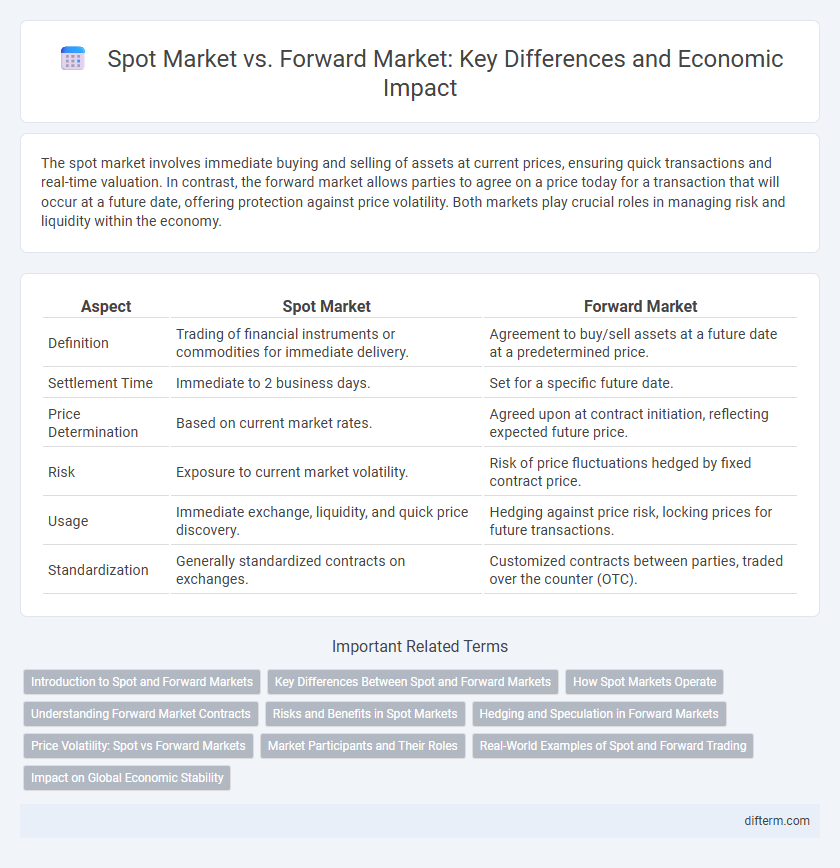The spot market involves immediate buying and selling of assets at current prices, ensuring quick transactions and real-time valuation. In contrast, the forward market allows parties to agree on a price today for a transaction that will occur at a future date, offering protection against price volatility. Both markets play crucial roles in managing risk and liquidity within the economy.
Table of Comparison
| Aspect | Spot Market | Forward Market |
|---|---|---|
| Definition | Trading of financial instruments or commodities for immediate delivery. | Agreement to buy/sell assets at a future date at a predetermined price. |
| Settlement Time | Immediate to 2 business days. | Set for a specific future date. |
| Price Determination | Based on current market rates. | Agreed upon at contract initiation, reflecting expected future price. |
| Risk | Exposure to current market volatility. | Risk of price fluctuations hedged by fixed contract price. |
| Usage | Immediate exchange, liquidity, and quick price discovery. | Hedging against price risk, locking prices for future transactions. |
| Standardization | Generally standardized contracts on exchanges. | Customized contracts between parties, traded over the counter (OTC). |
Introduction to Spot and Forward Markets
Spot markets facilitate the immediate purchase and sale of financial instruments or commodities, with transactions settled "on the spot" at current market prices. Forward markets involve agreements to buy or sell assets at a predetermined price on a specified future date, allowing participants to hedge against price volatility. Both markets play critical roles in price discovery and risk management within the global economy.
Key Differences Between Spot and Forward Markets
Spot markets involve the immediate exchange of financial instruments or commodities at current prices, enabling instant settlement and delivery. Forward markets, by contrast, facilitate contracts for assets to be bought or sold at a predetermined price on a future date, allowing participants to hedge against price volatility. The primary differences lie in transaction timing, price certainty, and risk management capabilities inherent to each market type.
How Spot Markets Operate
Spot markets operate by facilitating the immediate purchase and sale of commodities, securities, or currencies at current market prices, known as spot prices. Transactions in spot markets are settled instantly or within a short period, typically two business days, ensuring quick ownership transfer and liquidity. These markets are essential for price discovery and allow participants to hedge against price volatility through immediate trade execution.
Understanding Forward Market Contracts
Forward market contracts enable buyers and sellers to lock in prices for assets or commodities at a future date, reducing exposure to price volatility. These contracts are customized agreements traded over-the-counter (OTC), offering flexibility in terms and settlement compared to standardized spot market transactions. Understanding forward contracts involves recognizing their role in hedging risks and facilitating price discovery in volatile economic environments.
Risks and Benefits in Spot Markets
Spot markets offer immediate transaction settlement, reducing counterparty risk due to the prompt exchange of assets and payments. They provide price transparency and liquidity, enabling participants to capitalize on current market conditions without the uncertainties of future price fluctuations. However, spot markets expose traders to volatility risk as prices can change rapidly, potentially impacting profitability in short timeframes.
Hedging and Speculation in Forward Markets
Forward markets enable businesses to hedge against future price volatility by locking in prices for commodities or currencies, reducing exposure to market risk. Speculators in forward markets assume risk by betting on price movements, aiming to profit from anticipated changes, thereby providing liquidity and price discovery. This risk transfer mechanism distinguishes forward contracts from spot transactions that involve immediate exchange.
Price Volatility: Spot vs Forward Markets
Price volatility in the spot market is typically higher due to immediate delivery and real-time demand-supply fluctuations, causing rapid price changes. The forward market offers price stability by locking in prices for future transactions, reducing exposure to short-term market shocks. Hedging through forwards mitigates risk from spot price unpredictability, making it essential for businesses managing commodity costs.
Market Participants and Their Roles
Market participants in the spot market primarily include traders and businesses seeking immediate delivery and payment for commodities or financial instruments, enabling real-time price discovery and liquidity. In the forward market, participants mainly comprise hedgers, such as producers and consumers, who use contracts to lock in prices for future transactions, and speculators aiming to profit from price fluctuations. Clearinghouses and brokers facilitate both markets by ensuring contract enforcement and providing a platform for matching buyers and sellers.
Real-World Examples of Spot and Forward Trading
Spot market transactions occur when commodities like crude oil are bought and sold for immediate delivery, exemplified by the New York Mercantile Exchange where traders exchange energy products at current prices. Forward market trading is illustrated by agricultural firms locking in prices for wheat delivery months ahead through OTC contracts, protecting against price volatility. These real-world practices highlight how spot markets address instant demand, while forward markets enable risk management over time.
Impact on Global Economic Stability
Spot markets enable immediate asset exchange, promoting liquidity and rapid price adjustments that stabilize short-term global trade. Forward markets allow businesses to hedge against future price fluctuations, reducing uncertainty and supporting long-term investment planning. The balance between spot and forward market activities contributes to overall financial market resilience and economic stability worldwide.
Spot Market vs Forward Market Infographic

 difterm.com
difterm.com